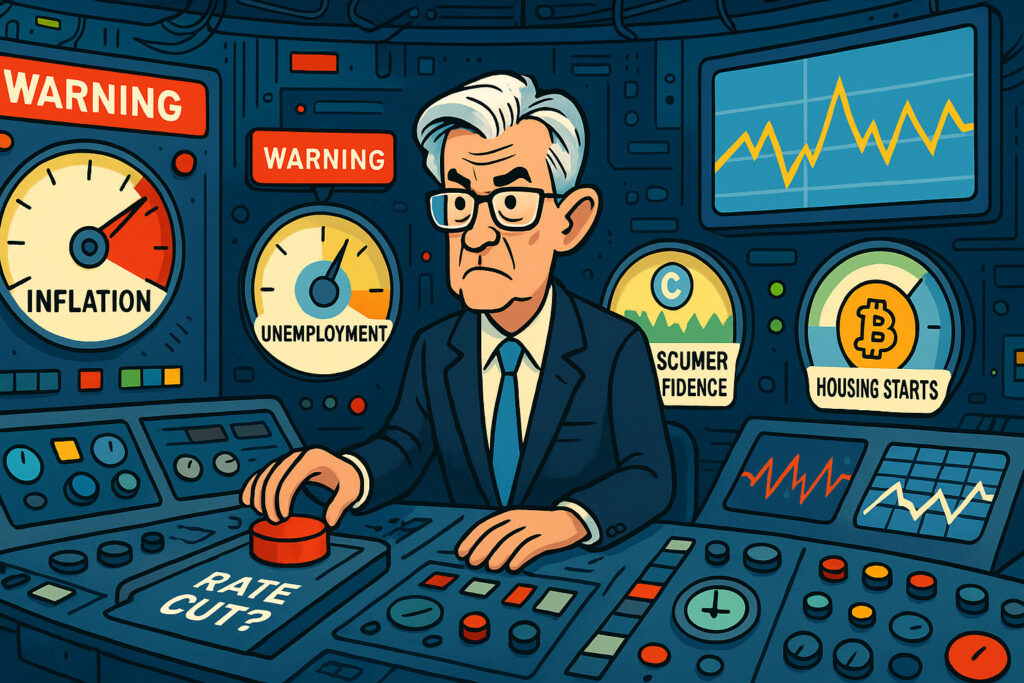Introduction
In a much-anticipated decision today, the U.S. Federal Reserve opted to keep its benchmark interest rate unchanged at a target range of 4.25%–4.50%, signaling a measured stance as inflation remains elevated and economic signals grow increasingly mixed. The outcome of the May 2025 Federal Open Market Committee (FOMC) meeting reinforces the Fed’s commitment to a data-driven approach while managing investor expectations around future monetary policy moves.
While the central bank acknowledged resilient consumer spending and a tight labor market, it also flagged concerns over persistent core inflation and international volatility—particularly in energy prices and geopolitical tensions in the Middle East. The market reaction was nuanced: major indices showed modest gains, with investors parsing Chair Jerome Powell’s language for clues about potential rate cuts later in the year.
The Fed Decision: Patience in an Uncertain Climate
Chair Powell struck a balanced tone during his post-meeting press conference, noting that while inflation has declined from its 2022 peak, the disinflationary process has stalled in recent months. He reiterated the Fed’s long-standing goal of bringing inflation back to the 2% target and expressed confidence in the underlying strength of the U.S. economy.
“We continue to see a path toward restoring price stability without triggering a severe recession. However, we are prepared to adjust our stance should inflation or labor market dynamics change materially,” Powell stated.
The vote to hold rates was unanimous, reflecting growing consensus among policymakers that additional tightening may not be necessary unless inflation surprises to the upside. The Fed’s accompanying statement showed minimal changes, but the omission of language about “possible further hikes” caught the market’s attention.
Fed Funds Rate Path
Currently, futures markets (CME FedWatch Tool) show a 64% probability of a rate cut by September 2025. However, today’s decision and Powell’s careful messaging suggest that any loosening of monetary policy will be contingent on sustained evidence of declining inflation.
Economic Backdrop
Today’s decision comes against a backdrop of mixed economic data:
- Core PCE (Personal Consumption Expenditures) inflation remains sticky at 3.2% year-over-year.
- April’s jobs report showed a slight uptick in unemployment to 4.1%, though job creation remained solid at 198,000 non-farm payroll additions.
- Retail sales have outperformed expectations, pointing to continued consumer resilience.
- Housing market activity has softened, with March housing starts falling 6.2% month-over-month.
- ISM Manufacturing PMI continues to contract, recording a reading of 47.9 in April, below the 50.0 growth threshold.
The combination of persistent inflation in services, slowing industrial output, and a cooling housing market presents a complex picture for policymakers trying to fine-tune monetary policy.
Market Reaction
U.S. Equities
Markets initially wavered on the announcement but ended the day in the green:
- S&P 500: +0.52% to 561.68
- Nasdaq Composite: +0.38% to 483.23
- Dow Jones Industrial Average: +0.55% to 410.49
Investors favored financials and industrials, while rate-sensitive sectors like real estate and consumer discretionary lagged.
Commodities
- Gold pulled back to $2,314 per ounce (-1.13%), after recent highs driven by geopolitical risk and inflation fears.
- WTI Crude Oil slipped below $78 per barrel, down 0.68%, as rising U.S. inventories offset supply disruptions in the Middle East.
Cryptocurrencies
- Bitcoin (BTC) surged 1.72% to $96,523, continuing its upward momentum amid investor hedging against fiat uncertainty.
- Ethereum (ETH) rose 1.67% to $1,805.58, supported by growing institutional interest ahead of possible ETF approvals.
Sector Impact and Investor Sentiment
Financials
Banks and insurance companies benefited from stable rates and strong consumer credit performance. JPMorgan Chase (JPM) closed up 1.1%, while Goldman Sachs (GS) rose 0.9%.
Technology
Despite a positive Nasdaq close, tech stocks showed mixed results. Apple (AAPL) dropped 0.3%, reflecting profit-taking after last week’s earnings. AI-heavyweights like Nvidia (NVDA) gained 0.6%, supported by bullish analyst revisions.
Real Estate
Real estate investment trusts (REITs) fell broadly, with the Vanguard Real Estate ETF (VNQ) dropping 1.2% amid concerns that high borrowing costs may persist longer than hoped.
Investor Sentiment
The CBOE Volatility Index (VIX) closed at 13.8, suggesting complacency despite underlying macro risks. Analysts warn that the next CPI print, due next week, could reshape rate expectations once again.
Analyst Views
Several prominent strategists weighed in:
- Bank of America economist Michelle Meyer noted, “The Fed has moved to a firm hold, but the door remains open. We expect a first rate cut in December, assuming inflation continues its glide path.”
- Morgan Stanley’s equity strategist Mike Wilson cautioned that “equity valuations remain stretched, and market breadth is deteriorating.”
- Goldman Sachs maintained its bullish stance on U.S. equities, arguing that AI-driven productivity gains will offset monetary headwinds.
What to Watch Next
Key data releases that could impact the Fed’s outlook:
- CPI – May 14: The next inflation report is expected to show modest disinflation in core services.
- Retail Sales – May 15: Consumer strength remains a pillar of GDP growth.
- FOMC Minutes – May 22: Will offer deeper insight into internal Fed debates.
- Jackson Hole Symposium – August: A major venue for signaling policy shifts.
Conclusion: A Delicate Dance
Today’s Fed decision underscores a cautious but optimistic central bank navigating a high-stakes environment. Chair Powell’s tightrope walk between curbing inflation and maintaining economic momentum continues, with the balance of risks gradually shifting toward the downside.
For investors, the message is clear: the Fed is on hold, but not done. Markets remain acutely sensitive to every data release and Powell’s every word. With macroeconomic uncertainty high, diversified positioning and disciplined risk management remain critical.
The next few months could redefine the economic narrative for 2025. Whether the Fed can stick the landing will depend on both global forces and the continued resilience of the U.S. consumer.
Disclaimer: This article is for informational purposes only and does not constitute financial advice. Please consult with a professional advisor before making investment decisions.
